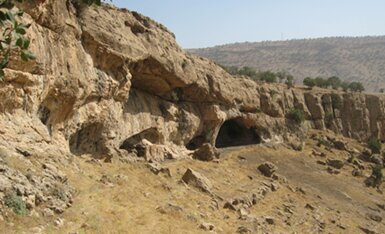Archaeologists discover new clues of cave dwelling in western Iran

TEHRAN--Ancient cave dwelling remains in Eivan city of the western province of Ilam, indicate the existence of early human beings in the Zagros area, said Habibollah Mahmoudian, a faculty member at Islamic Azad University of Ilam.
He told ISNA that the geographical area of Eivan was the settlement of cave dwellers.
Archaeological studies in this region have discovered evidence of early human beings and related objects in various caves such as Khofash cave, Barreh Zard cave, and Baskeleh-ye Garmeh cave.
Zagros, as the most extensive mountain range of Iran, has numerous caves and shelters, some of which have historical importance and others are significant in terms of their scientific nature.
The caves located in Eivan particularly in slopes of mountains of Sivan, Kabirkuh, Chehel Sotoon, Darreh Deraz, show the preliminary phases of human settlement.
He explained that Baskeleh village is one of the ancient regions which is located 18 kilometers north of Eivan. It is in the main route to Kermanshah, he said, adding there are numerous caves that are of high importance in terms of archeological studies.
Baskeleh-ye Garmeh I cave is located in southern slope of Dizgeh mountain, northwest of Baskeleh village. The walls and ceiling of the cave are made of natural stones.
Potteries have been seen in the area, he said, adding based on available findings, they may belong to Chalcolithic era (Copperstone).
Baskeleh-ye Garmeh II is located two kilometers off Baskeleh village. The existence of cultural symbols at this location increases the likelihood that it belongs to a historical era.
Baskeleh-ye Garmeh III is located three kilometers off Baskeleh village and at height of 220 meters. There are scattered potteries in the area.
Baskeleh-ye Garmeh IV is located 3.5 kilometers off Baskeleh in slopes of Gavmehr Mountain. This cave is like a rock shelter.
The potteries found here include simple and handmade potteries using plant-based chamotte. The presence of an obsidian blade in this area also indicates its use in the Chalcolithic era.
He pointed out that studying these sites face numerous challenges. The extensive diversity of the sites, difficult access to some caves and lack of documentaries are major hinderances toward precise identification of the cultural and civilizational developments of humans in this area, he mentioned.
However, these findings can pave the grounds for furthers research on social, cultural and environmental developments of cave dwellers in Eivan, he concluded.
Ilam is located on the foothills of the Zagros Mountains in the western region of Iran. Unlike The north and northwest part of this province which is mountainous, the west and southwest are flat. It is a suitable place for nomad life since the geographical conditions are favorable for summer and winter relocation.
The common handicrafts of this province include carpet, rug, drugget, felt, and coarse blanket weaving. The majority of the people in Ilam are Kurds, Laks, and Lurs, they speak in Laki, Kurdish, and Luri. Based on the archeological excavations in Ali Kosh ancient area, the civilization of this province dates back to New Stone Age circa 8000 BC.
The land which is called Ilam now was a part of the ancient Elamite civilization that was formed circa 3000 BC and was destroyed by Assyrian King Ashurbanipal in 640 BC.
Elam was an ancient pre-Iranian civilization centered in the far west and south-west of what is now modern-day Iran, stretching from the lowlands of what is now Khuzestan and Ilam provinces as well as a small part of southern Iraq.
KD
Leave a Comment